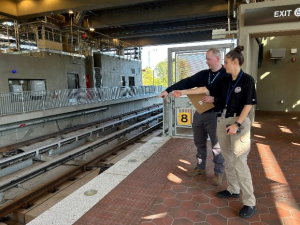It was around 4 a.m. when TSA Surface Inspector (TSI) Thomas Pitts, dressed casually in street clothes, rang the bell at a mass transit bus facility and said he was the new mechanic who just wanted to get to work early and look around before settling in. Once inside, he not only looked around, but he explored the facility for a while before leaving, telling the dispatcher he would come back.
Only a few weeks on the job, Pitts, the newest TSI on the inspections team out of Ronald Reagan Washington National Airport, already successfully socially engineered his way into what was supposed to be a secured bus facility.
It’s part of TSA’s effort to protect the nation’s surface transportation system by looking for possible vulnerabilities. The Security Enhancement Through Assessment (SETA) program is one of a handful of surface transportation partnership programs TSA offers to surface operators.
TSA’s Surface Operations works to improve and safeguard surface transportation security by enhancing the security preparedness and resilience of the nation’s surface transportation systems by collaborating with industry and other government partners.
“The SETA program, which a surface transportation agency voluntarily seeks to participate in, consists of five key elements,” explained Supervisory TSI Josh Grey, an inspector since 2016. “The elements – identify, assess, mitigate, reassess and sustain – are completed in three phases during a 90-day period.”
Grey said in the first phase, TSA schedules a site visit, initial assessment and immediately lets surface operators know what the inspectors observed. During the second phase, the inspectors seek to help an agency mitigate their vulnerabilities by providing training.
For example, “we will offer briefings on pre-trip security inspections such as what a bus or rail operator should look for,” Grey said. “The third phase includes a reassessment to help determine if the training we provided helped improve the security of a site and to help develop a plan to maintain an effective security posture.”
During a site visit, inspectors might try to conceal unattended or suspicious items in vulnerable locations to determine whether a vehicle operator is conducting a thorough security inspection as part of their pre-trip inspection.
Grey’s team focuses on the busy National Capital Region, which includes northern Virginia, Washington, D.C., and parts of Maryland and works with rail, subway, passenger bus and school bus operators.
The team recently visited the newly opened Potomac Yard-Virginia Tech Metrorail station in Alexandria, Virginia, where they conducted a station profile. They scoured the station from the entryway to the fare gates and onto the platform, counting cameras, photographing and taking notes on emergency exits, locations of trash bins, See Something, Say Something® signage, fire extinguishers, automated external defibrillators, evacuation carts, lighting, intrusion detection systems, perimeter security and even adjacent bus locations and other security-related features.




